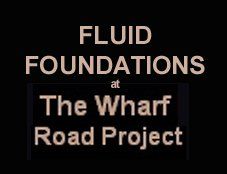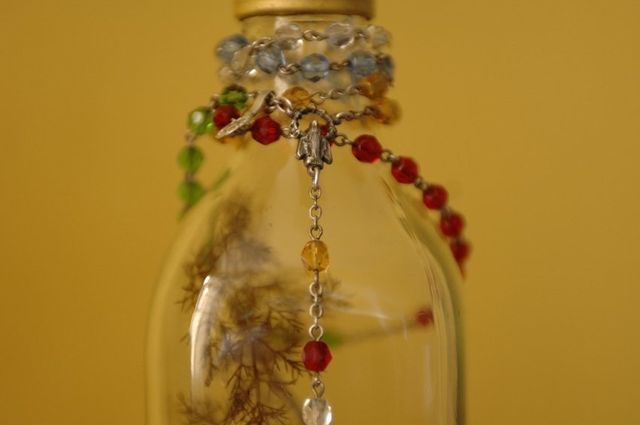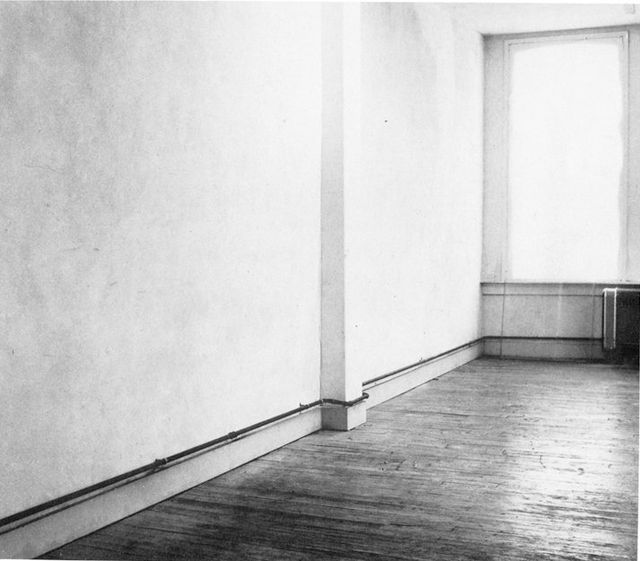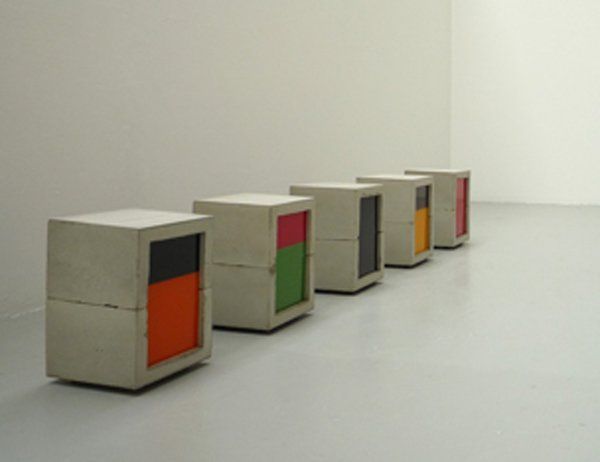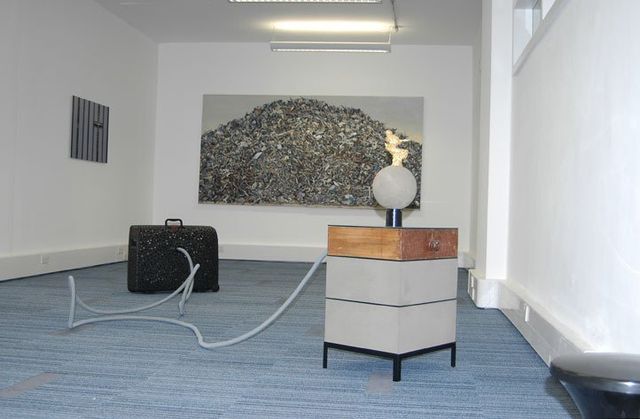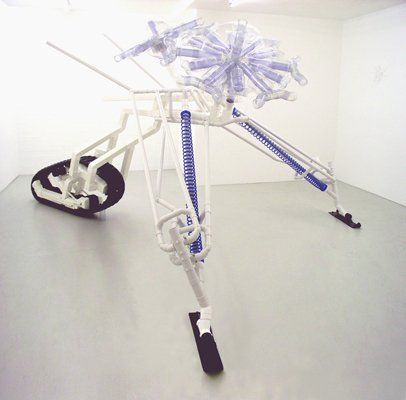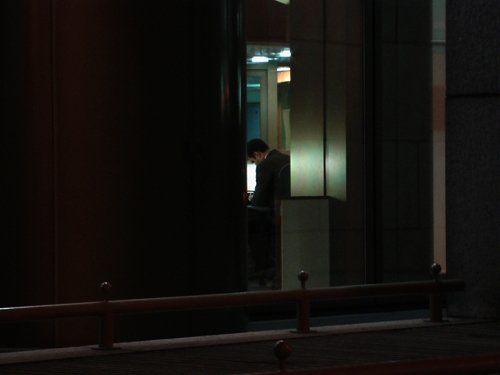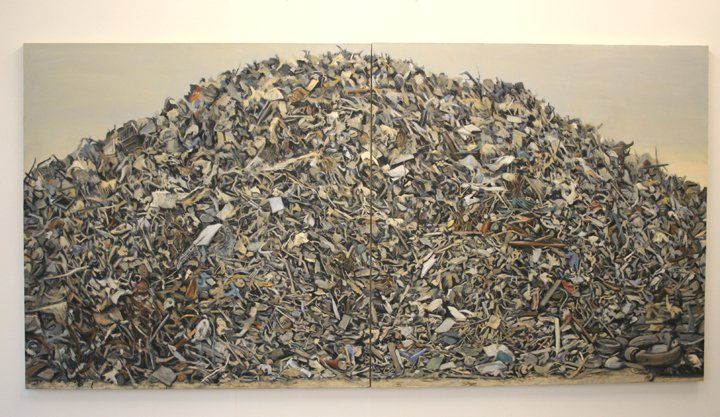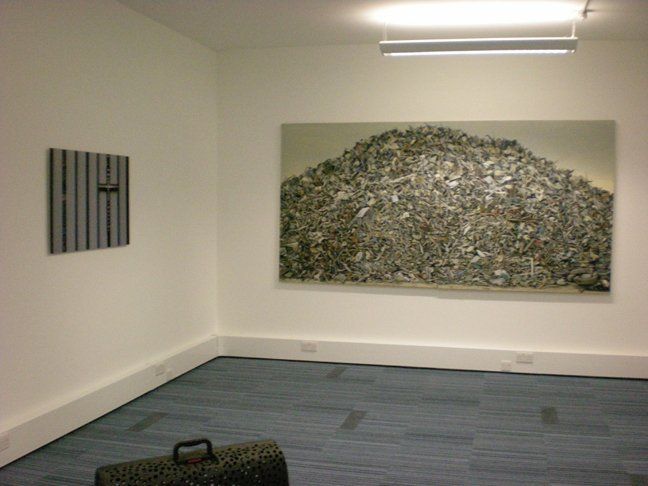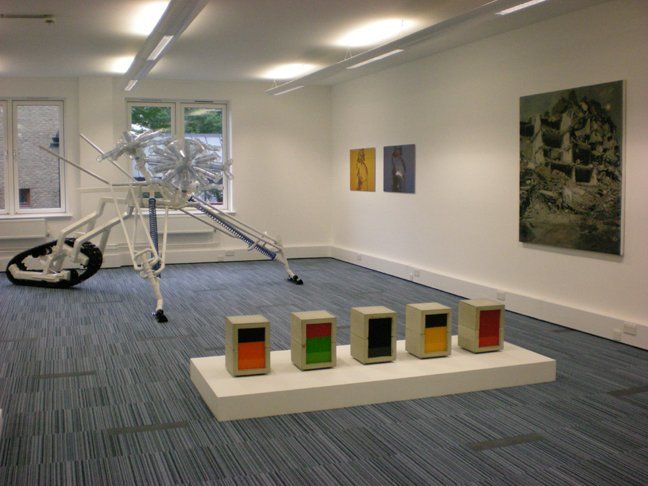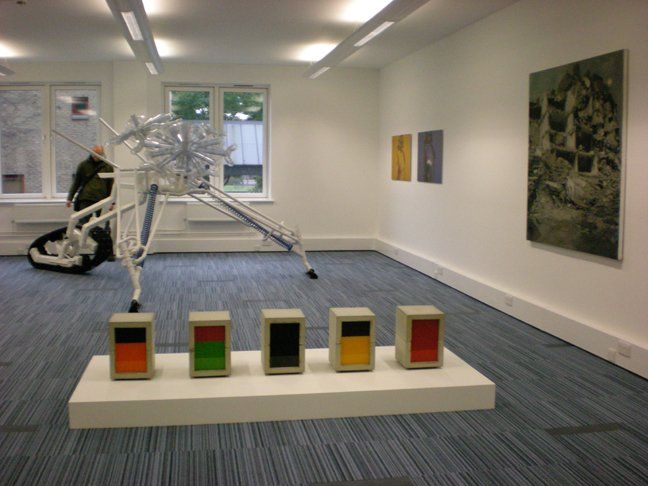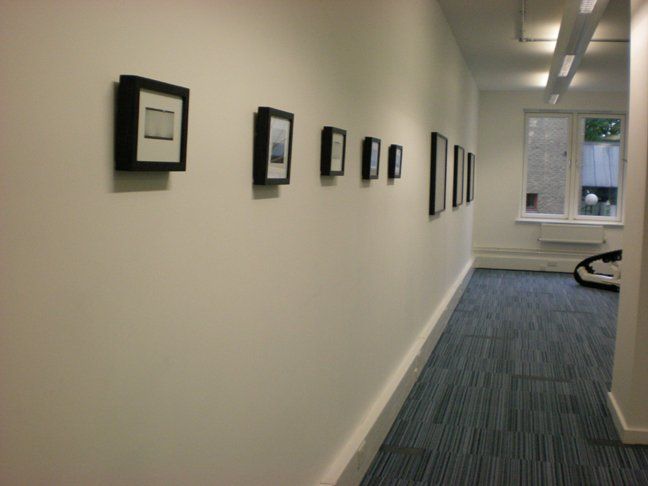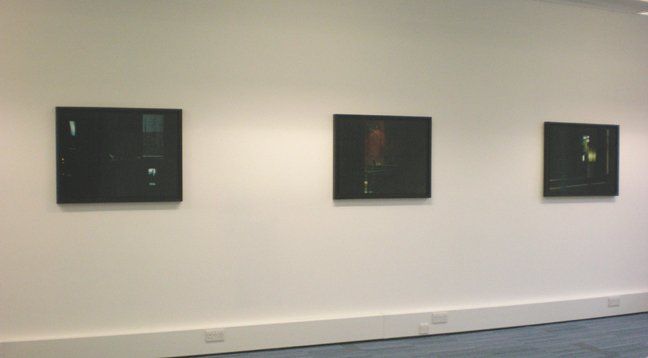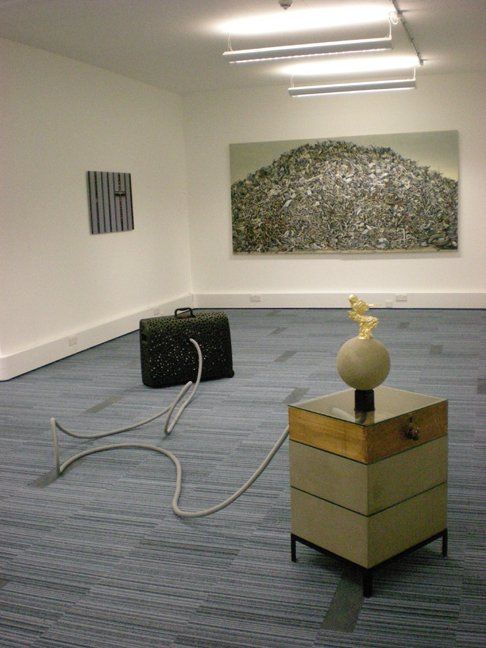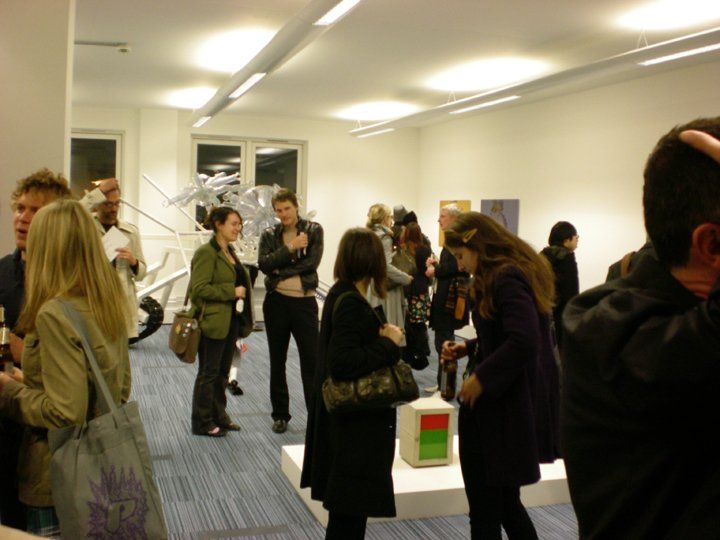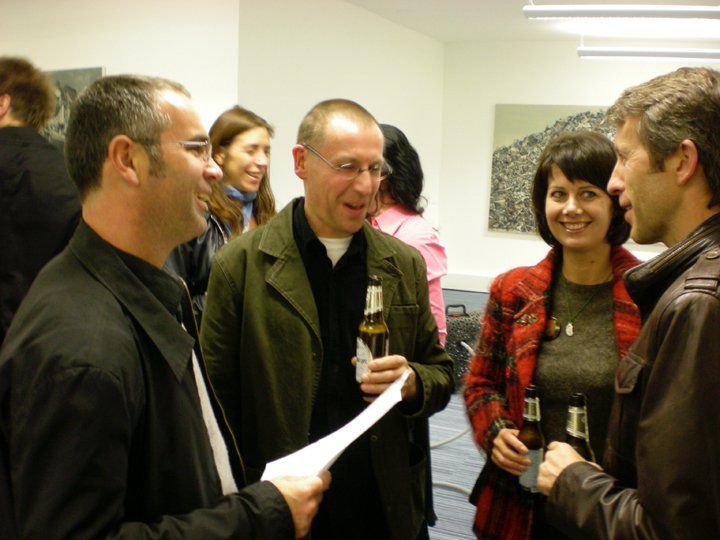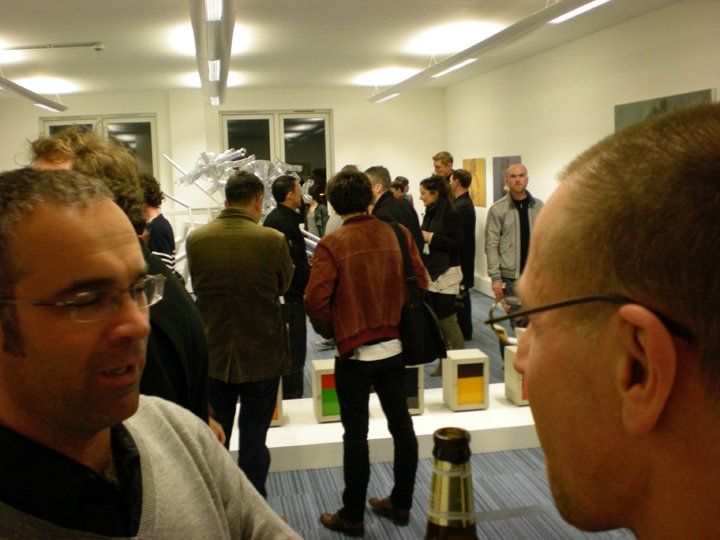MONICA BIAGIOLI - JOHN CLAYMAN - BEN COVE - RICHARD DUCKER
STEWART GOUGH - KATHLEEN HERBERT - LEE MAELZER
Given the inescapable statement of the building’s function, Richard Ducker of Fieldgate Gallery, has curated an exhibition around the idea of architectural and flights of fancy that respond to the strong office sensibility of the space.
The built environment is the landscape which we all occupy, and although architecture has the illusion of permanence, our relationship to it is fluid and often uneasy. It can inspire awe through its spectacle, or be the backdrop to real or cinematic narratives: crime, romance, consumerism, work, recreation. With these sites we experience complex psychological responses, sometimes extreme and often contradictory. There is an accumulation of history, re-animated for the present, while the present lacks stability, slipping back into the historical narrative from which it emerged. Within this, like a soap opera, lie individual stories, human exchanges.
Each of the artists in this exhibition explores in different ways the notion of our relationship to the architectural. Some make a direct reference through their material language, while others explore the more human or domestic. The human presence here tends to be inferred rather than portrayed, and we are left with a landscape of absence and boredom, while fascination is found in the banal and insignificant, and intimations of a longing for a somewhere else beyond the office desk.
The Wharf Road Project brings more than 20 innovative contemporary art initiatives together for the first time in a central location, creating a seminal showcase for the more unusual and innovative. The Wharf Road Project is not an art fair, but a large-scale exhibition featuring the best of London’s specialist and experimental art spaces, complemented by a programme of performances, screenings, music and guided tours. Participants have each been allocated one of the 5-storey venue’s rooms to curate exhibitions which reflect their artistic endeavours and curatorial ethos. This mash-up of different organisations will create an opportunity to engage with established art spaces as well as some of the newest and most exciting art initiatives in London.
PARTICIPANTS INCLUDE: Carter Presents; David Risley; E:vent; The Hex; Parade; Seventeen; Stedefreund, Berlin; Supplement; Frog Morris with Lee Campbell; Matt Williams; Dallas Seitz, Lisa Penny & Trevor Hall; Collecting Live Art; Everyday press; Fieldgate; Igloo; Linda Persson & Natasha Rees; PILOT; Poignancy passing Muster; TOM ROWLAND FINE ART; Truck Art; MOT Presents: THE NEW DOME; Fergal Stapleton, courtesy Carl Freedman; Laura White invites Alison Wilding, Bettina Buck and Phyllida Barlow; Peter Jones, courtesy of Pizza Horse and the Fat Sisters; The David Roberts Art Foundation; Martin Creed for V22; Martin Westwood for V22
The Wenlock Building
50-60 Wharf Road
London N1 7RN
Closest tubes: Angel and Old Street
supported by V22, Workspace Group PLC and Arts Council England
BEN COVE
My work ranges from painting and sculpture, to installed works, drawing, digital work and video. Originally trained in architecture, my work often takes its cue from the legacy of Modernism. In particular I am interested in the endeavour and the propositional; that which is offered up for evaluation or contemplation. Often borrowing from existing models that are conceived as optimistic or progressive, I am interested in the relationship between form and function; usefulness and uselessness, structure and decoration, brash and sober. There is a formal interest in the placing of pattern and colour alongside more mute materials; flat colour on linen, cast concrete with coloured glass or timber with coloured wool. I construct objects and images which are familiar but ambiguous. The relationship between the monumental and the intimate is explored through the uncertainty of scale. The work is characterised by a playfulness and dumbness which sits alongside an apparently serious intent. The play between the fictional and the real manifests itself in the ambiguity of pictorial space. Pieces seem to declare themselves but give little away.
RICHARD DUCKER
The use of cement in Richard Ducker’s most recent sculptures emphasises a kind of death, or a modernist monumentality, but the objects it coats and with which it is juxtaposed evoke nostalgia, myths soaked in dreams, and fairy tales gone wrong. If a domestic interior is evoked, it is one in which homely things have sprouted aggressive appendages, grown unexpected textures, or multiplied into viral aggregates, as if to embody the nightmares that commodity fetishes might dream of if they fell asleep. Like Proust’s madeleine dipped in tea, they evoke memories and sensations according to a logic that combines cultural association with phenomenological fantasies of sensual experiences, often clashing within the same piece. In Death Star (and Baby), for example, the familiar shape of plastic bottles is made strange by a coating of intensely black flock, at once attractive and repellent in its soot-like impurity, contrasting the smooth sensation of drinking ‘spring water’, with the gagging artificiality of spray-flock; we are reminded with a jolt how toxic our obsession with purity and cleanliness really is. Lots of fluids seem to run through the work: sucked in by a fur-lined, mouth-like creature with the energy of a crack addict; apparently running between a suitcase – travel, escape and refreshing holidays – and a concrete block that seems to be feeding off (or to?) a tree that might have been killed or perhaps re-energised by artistic usage...
Sculptural processes have become the magic instruments of a post-Freudian fairy-tale, in which life and death, pleasure and pain, nourishment and poison have become entangled in an exchange that could lead to deadly battle, intense pleasure, or remain a secret. Emotionally evocative without ever telling a clear story, affecting without being obvious, Ducker’s sculptures seem to be there with the mute theatricality of minimalism, yet to engage with notions of transformation. With simple formal means, they excavate fears, anxieties and desires associated with the most visceral of physical sensations – attraction and repulsion, pleasure and pain, need and self-sufficiency. The work keeps referring back to the body, a missing body we as viewers cannot help but imagine filling- in for with our own, transforming it into the ill-fitting piece of a jigsaw we are trying in vain to complete with our presence.
-- Patrizia Di Bello, 2007New Paragraph
STEWART GOUGH
Stewart Gough‘s sculptures are assemblages of various mass-produced plastic objects fixed together as though Lego bricks; Dinner plates and food containers are held amongst pipe systems and machine parts, creating a distinct materially–merged–down space for a positively ironic sculptural investigation. Gough’s sculptures are temporary structures, referencing British Utopian Architecture of the 1960’s, often implying an integrated mode of transport, appearing decamped in operation as sculptural event. Through a deliberate use of size, scale, form, and graphical colour these works command phenomenal presence, and playfully slip between the grounding utility of their constituent parts and fantastic flight through sculptural and architectural ideology.
